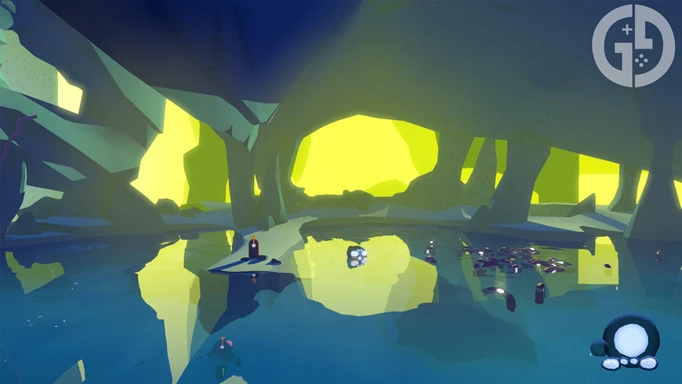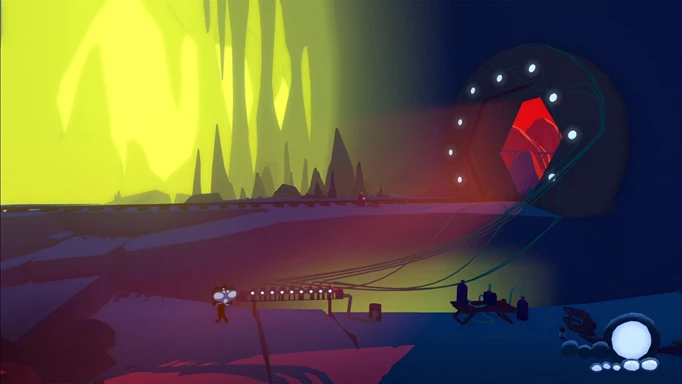Airhead review: Breathless

If there’s one thing that playing Airhead has taught me, it’s that I could never be a deep-sea diver or caver. You see, Airhead has all the hallmarks of a classic, curious indie Metroidvania - at least on paper. You play as a headless body, initially stumbling around your cavernous dwelling before coming across a mysterious head that emerges from the darkness. You quickly realise that you can pick up this head and wear it as your own, but that comes with caveats - it needs air to stay alive.
What follows is several hours of figuring out 2.5D environmental puzzles as you figure your way through gorgeously designed environments, picking up new abilities and making sense of the world for yourself as you go. However, the core gameplay loop of constantly needing to fill up on air quickly becomes stale, resulting in an experience that swiftly turns from wonderment to anxiety-inducing.
GGRecon Verdict
Airhead has redeeming qualities, including stunning art direction, an amazing soundscape, and a steady drip-feed of upgrades that serve to keep the gameplay loop fresh. Metroidvania fans who have the patience to stick out the frustrating gameplay will find themselves an incredible world to explore, and one that’s filled with an interesting story, concept, and secrets.
However, the core gameplay loop quickly spirals from being an interesting gimmick to an infuriating irritation, and it’s not one that I can see most casual players enjoying all that much.
Brave new world

 Click to enlarge
Click to enlargeIf there’s one thing that Airhead is, it’s a unique concept. While very much a single-player title, it pays to think of the game as almost a co-op experience, as Body and Head quickly become symbiotic shortly after crossing paths.
The gameplay almost completely revolves around Head, as he must always remain inflated to stay alive. If Head dies, it’s game over and you respawn back at where you last stocked up on air. That’s done at little Red oxygen canisters, which are littered generously around much of Airhead’s gorgeous environments. Every time you inflate, the game autosaves, which means you’re never usually backtracking far if you mess up a puzzle.
Where things get interesting is that Body can take off Head, and you’ll need to do so regularly to solve the many environmental puzzles in your way. For example, when Head is picked up, Body can’t jump quite as high, and it also can’t swim beneath the surface of the water unless Head is deflated.
Throw in different types of air and progressive upgrade items, and there’s plenty of variety in the puzzles you both come across. For example, Helium canisters can send both Head and Body flying into the sky, allowing you to reach new heights to solve certain puzzles.
Additions to Body and Head’s array of tricks arrive fairly regularly throughout the story of Airhead, which keeps things fresh and engaging just when the last new mechanic starts to get a bit stale.
Redeeming qualities

 Click to enlarge
Click to enlargeAirhead’s most standout feature is its art design. Featuring bold, bright colours juxtaposed with gloomy shadows, the art team at Octato has outdone itself in creating a world that’s gorgeous to look at, and makes you want to explore its many nooks and crannies. Most of my time with Airhead was played on a Steam Deck OLED, which truly made the game pop at every turn.
A small amount of visual grain and an accompanying soundtrack all add to an incredible atmosphere that builds up a story I genuinely wanted to know more about. Where did Head come from? Why does it need air to survive but these bodies don’t? What are these occasional robots doing, and where do they come from?
It’s a narrative that is reminiscent of games like Inside, which I mean only as a compliment. There’s a certain tension in the environment of Airhead that I can’t quite put my finger on, and that’s what drove me to want to explore more of this delightful, but also remarkably grim world.
However, the world design does occasionally clash with the gameplay of Airhead. While the parallax sprawls of the 2.5D world are easy on the eye, they can get quite confusing when traversing it. Some puzzles require you to jump onto paths behind your current position, which can be a little tricky to do with the occasionally unresponsive controls.
What’s more, it’s never completely clear which path you can walk on and which ones you can’t, which led to several frustrating puzzles when I thought I could easily walk to a spot on the map, only to find out that wasn’t the desired route.
Wasted potential

 Click to enlarge
Click to enlargeFrom its art design to its innovative gameplay mechanics, there’s lots to love about Airhead. However, its biggest downfall is that the loop of constantly needing to fill up on air very quickly stops being interesting and turns into a genuine source of anxiety.
Air is consumed whenever Head and Body exert any sort of effort, like moving or jumping, and there are plenty of air canisters to keep you stocked up along the way. They’re always placed just far enough apart so that you can get from one to another without needing to fill up, but there’s very little wiggle room. Mess up a jump with the lethargic controls, and you’ll be asked to walk that path once more.
This becomes a problem when trying to figure out Airhead’s many environmental puzzles, as there’s little chance to have a walkabout and assess what needs to be done to solve it. While you do find additional air bubbles to add to your meter, your air only lasts for around five seconds at the beginning of your journey.
Filling up on air never felt like it added needed tension to the gameplay, it quickly became a frustrating annoyance. The core mechanic of Airhead becomes such an inconvenience that it sadly overrides any desire to explore that gorgeous world and leaves puzzle solving feeling less of an achievement, more of a 'thank god that's over'.
The Verdict
Airhead has redeeming qualities, including stunning art direction, an amazing soundscape, and a steady drip-feed of upgrades that serve to keep the gameplay loop fresh. Metroidvania fans who have the patience to stick out the frustrating gameplay will find themselves an incredible world to explore, and one that’s filled with an interesting story, concept, and secrets.
However, the core gameplay loop quickly spirals from being an interesting gimmick to an infuriating irritation, and it’s not one that I can see most casual players enjoying all that much.
3/5
Reviewed on PC. Review code provided by the publisher.
